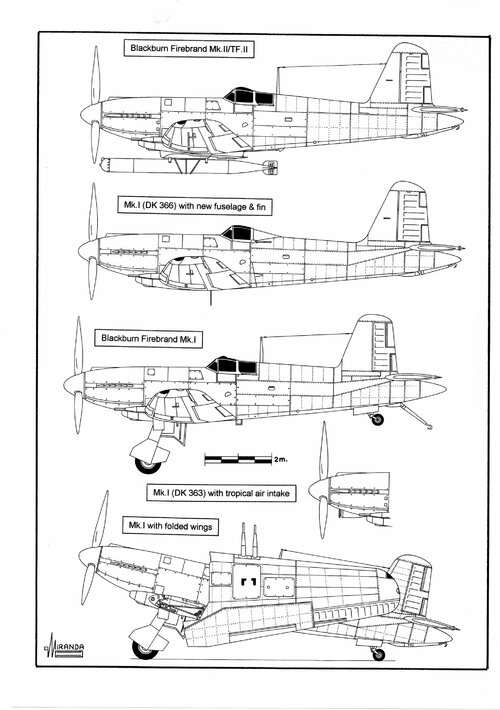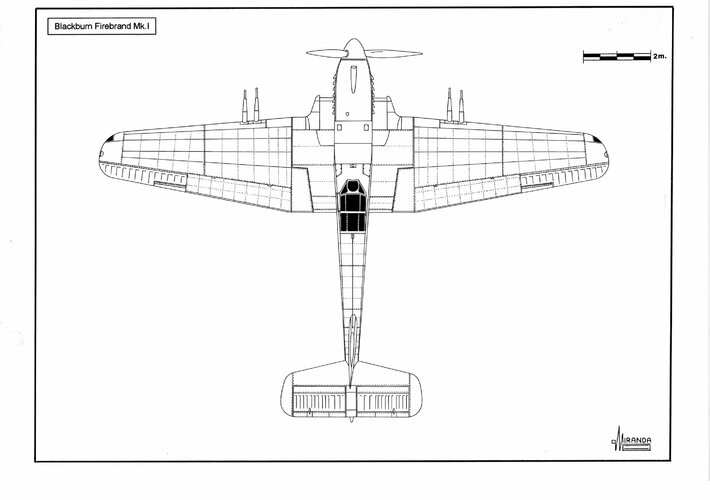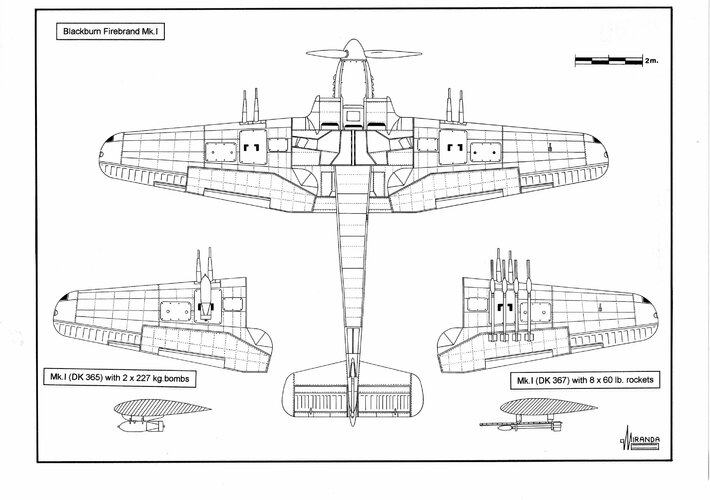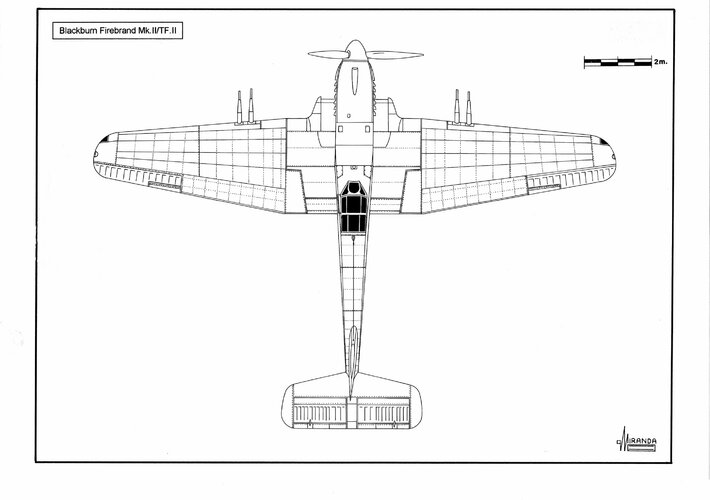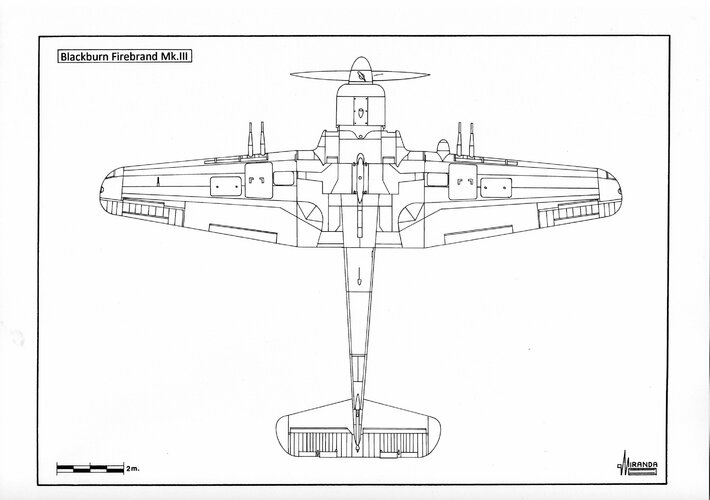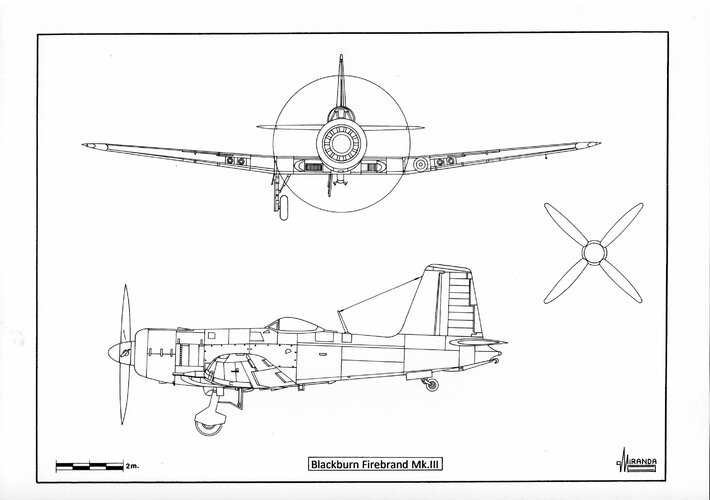Blackburn B-37 Firebrand
You are using an out of date browser. It may not display this or other websites correctly.
You should upgrade or use an alternative browser.
You should upgrade or use an alternative browser.
Blackburn B-37 Firebrand
- Thread starter Justo Miranda
- Start date
- Joined
- 19 July 2016
- Messages
- 4,262
- Reaction score
- 3,445
Why?
42Why?
- Joined
- 19 July 2016
- Messages
- 4,262
- Reaction score
- 3,445
I thought 42 was a ?wat?
Low energy perhaps.
Low energy perhaps.
Blackburn B-37 Firebrand
In March 1939 the Air Ministry published the specification N.8/39 as a two seat replacement naval fighter for the Skua, Fulmar and Sea Gladiator of the Fleet Air Arm.
The demands of the war forced the modification of the N.8/39 as N.11/40 by the end of 1939, requesting a short-range, single-seat, carrier borne interceptor, armed with four guns of 20 mm with a maximum speed of 644 km/h and an endurance of 4 hours.
Blackburn proposed the B-37, a new design specifically conceived for shipboard operation, building a mock-up in September 1940.
This was chosen for mass production of which 50 units and three prototypes were ordered under the denomination Firebrand Mk.I.
The first prototype (DD 804) made its first flight on 27 February 1942 followed by the DD 810 on 15 July and by the DD 815 on 15 September.
The DD 810 was armed with four guns and it was used in February 1943 for landing tests aboard H.M.S. Illustrious.
The DD 815 was sent to Boscombe Down test centre for armament trials.
The new airplane proved to be quite unstable when in flight at low speed and the pre-production Mk.I series (after T.F.I) was shortened to just nine units (DK 363 to DK 371) out of which two were retained by Blackburn for structural tests and the rest were sent to Boscombe Down for flight and armament trials.
Several airplanes were sent back to the manufacturer to modify the control surfaces, longitudinal instability not being completely solved, and suffering no less than six accidents during the tests.
The DK 367 was used in July 1943 to test the installation of eight rockets under the wings and the DD 810 with racks for a 227 kg bomb below each wing.
The DK 366 had a cut down rear fuselage in an attempt to improve rudder control at high speed.
The DD 810 was reconstructed after an accident, widening the central section of the wing 39 cm to allow the installation of a torpedo under the fuselage centreline.
The airplane was registered again as NV 636 being used as prototype of the Mk.II version (later TF.II).
The reason for this change was the decision to cancel the construction of the Mk.I as the Fleet Air Arm already had two more efficient naval fighters available, the Seafire and the Corsair.
Twelve T.F.II (DK 374 to DK 385) were built, out of which one was retained by the manufacturer, three were sent to the Aircraft Torpedo Development Unit for armament testing, one to Boscombe Down for flight tests and the rest to the 708 Squadron for operational trials by mid-1944.
It was not possible to continue the production of the T.F.II due to the lack of Sabre engines that had been reserved exclusively for the Hawker firm for the production of the Typhoon.
The Sabre had produced many maintenance problems to the 708 Squadron and it was thought inadequate to be used for shipboard operation.
The rest of the Firebrand production (versions T.F.III, T.F.IV and T.F.V) was made using the radial engines.
The Firebrand TF.II aircraft in the 708 Squadron used the ‘O’ letter in the code indicating that they were used for testing purposes.
The DK 383 is known to have used the ‘OC’ code.
Mk.I technical data
Power plant: One Napier Sabre Mk III, 24 cylinder ‘H’, liquid cooled engine, rated at 2,305 hp, driving one de Havilland Hydromatic three-bladed constant-speed airscrew, wingspan: 50 ft (15.24 m), length: 37.7 ft (11.5 m), height: 13.3 ft (4.06 m), wing surface: 372 sq. ft (33.5 sq. m), maximum weight: 13,625 lbs (6,172 kg), maximum speed: 357 mph (574 kph), service ceiling: 32,500 ft, range: 805 mls (1,295 km), armament: four wing-mounted 20 mm Hispano Mk.II cannons with 200 rounds per gun.
T.F.II technical data
Power plant: One Napier Sabre Mk III, 24 cylinder ‘H’, liquid cooled engine, rated at 2,305 hp, driving one de Havilland Hydromatic three-bladed constant-speed airscrew, wingspan: 51.2 ft (15.63m), length: 38 ft (11.6 m), height: 13.3 ft (4.06 m), wing surface: 378 sq. ft (34 sq. m), maximum weight: 15,046 lbs (6,816 kg), maximum speed: 355 mph (571 kph), range: 767 mls (1,234 km), armament: four wing-mounted 20 mm Hispano Mk.II cannons and one 457 mm torpedo with 838 kg.
T.F.V technical data
Power plant: One Bristol Centaurus IX, 18 cylinder radial, air cooled engine, rated at 2,520 hp, driving a four-bladed, constant-speed Rotol airscrew, wingspan: 51.2 ft (15.63m), length: 39 ft (11.91 m), height: 15.2 ft (4.63 m), wing surface: 378 sq. ft (34 sq. m), maximum weight: 17,500 lbs (7,927 kg), maximum speed: 340 mph (547 kph), service ceiling: 28,500 ft, range: 740 mls (1,190 km), armament: four wing-mounted 20 mm Hispano Mk.II cannons and one 457 mm torpedo with 838 kg.

